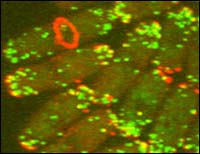

Yale researchers have reported a method to count the absolute number of individual protein molecules inside a living cell, and to measure accurately where they are located, two basic hurdles for studying biology quantitatively.
“The method makes possible accurate measurements of proteins inside cells using microscopic methods usually used just to show where proteins are located,” said senior author Thomas D. Pollard, M.D., Chair and Higgins Professor of Molecular, Cellular & Developmental Biology at Yale, of the work published in Science.
Postdoctoral fellow Jian-Qiu Wu attached a tag called yellow fluorescent protein to proteins of interest, allowing these proteins to be detected in live yeast cells with a light microscope. He used seven sample proteins to demonstrate that the brightness of the fluorescence is directly correlated with the amount of that protein in the cell.
With this reference, they could take a stack of pictures through any whole cell that makes a tagged protein, count up all the fluorescent signal, and calculate the number of molecules by comparing with their standardized sample proteins. The assay works whether the molecules are spread out or concentrated in particular parts of the cell, so they could also count the number of molecules in different locations throughout the cell.
Wu assayed the overall and local concentrations of more than two-dozen proteins. Some regulatory proteins had only a few hundred copies, while the common protein actin had millions of copies. The measurements revealed for the first time the ratios of proteins making up structures such as the “contractile ring” that pinches cells apart as they divide.
“People working on yeast should be able to use this method straight out,” said Pollard. “Tagging proteins by manipulating their genes is a bit more complicated in other organisms, but it can be done with some work — even in human or plant cells.”
“It is surprising that no one has made this calibration before. Biology has tended to be descriptive,” said Pollard. “This technology is part of moving biology to be more quantitative and mechanistic. You can’t understand the chemistry and physics of cells without knowing the concentrations of the proteins.”















